
Albuquerque, also known as ABQ, Burque, and the Duke City, is the most populous city in the U.S. state of New Mexico. Founded in 1706 as La Villa de Alburquerque by Santa Fe de Nuevo México governor Francisco Cuervo y Valdés, and named in honor of Francisco Fernández de la Cueva, 10th Duke of Alburquerque and Viceroy of New Spain, it served as an outpost on El Camino Real linking Mexico City to the northernmost territories of New Spain. In 2006, the city celebrated its 300th anniversary.
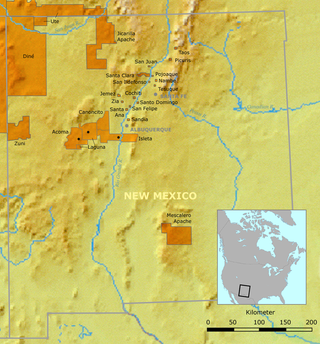
The Puebloans, or Pueblo peoples, are Native Americans in the Southwestern United States who share common agricultural, material, and religious practices. Among the currently inhabited Pueblos, Taos, San Ildefonso, Acoma, Zuni, and Hopi are some of the most commonly known. Pueblo people speak languages from four different language families, and each Pueblo is further divided culturally by kinship systems and agricultural practices, although all cultivate varieties of maize.
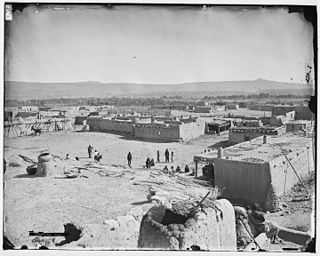
Cochiti is a census-designated place (CDP) in Sandoval County, New Mexico, United States. A historic pueblo of the Cochiti people, one of the Keresan Nations, it is part of the Albuquerque Metropolitan Statistical Area. The population was 528 at the 2010 census. Located 22 miles (35 km) southwest of Santa Fe, the community is listed as a historic district on the National Register of Historic Places.

Kewa Pueblo is a federally-recognized tribe of Native American Pueblo people in northern New Mexico, in Sandoval County southwest of Santa Fe. The pueblo is recorded as the Santo Domingo Pueblo census-designated place by the U.S. Census Bureau, with a population of 2,456 at the 2010 census.
The Pueblo Revolt of 1680, also known as Popé's Rebellion or Popay's Rebellion, was an uprising of most of the indigenous Pueblo people against the Spanish colonizers in the province of Santa Fe de Nuevo México, larger than present-day New Mexico. The Pueblo Revolt killed 400 Spaniards and drove the remaining 2,000 settlers out of the province. The Spaniards reconquered New Mexico twelve years later.

The Alvarado Transportation Center (ATC) is a multimodal transit hub located at 100 1st Street SW in Downtown Albuquerque, New Mexico. The complex was built as a hub for Albuquerque's regional transit system and as a replacement for Albuquerque's previous bus depot and train station. The center serves ABQ RIDE, Amtrak, Greyhound Lines, and the New Mexico Rail Runner Express commuter rail line.

The New Mexico Rail Runner Express is a commuter rail system serving the metropolitan areas of Albuquerque and Santa Fe, New Mexico. It is administered by the New Mexico Department of Transportation (NMDOT) and the Rio Metro Regional Transit District, a regional transportation agency, while Herzog Transit Services currently holds the contract for the operation and maintenance of the line & equipment. Phase I of the system, operating on an existing right-of-way from Belen to Bernalillo that NMDOT purchased from BNSF Railway, opened in July 2006. Phase II, the extension of the line to Santa Fe, opened in December 2008. Daily ridership, as of February 2019, was 2,200 trips per day. In 2022, the system had a ridership of 439,200, or about 2,500 per weekday as of the second quarter of 2023.
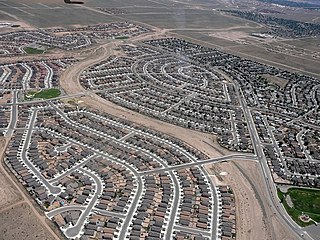
Rio Rancho is the largest and most populous city in Sandoval County, part of the expansive Albuquerque metropolitan area, in the U.S. state of New Mexico. A small portion of the city extends into northern Bernalillo County.

The historic U.S. Route 66 ran east–west across the central part of the state of New Mexico, along the path now taken by Interstate 40 (I-40). However, until 1937, it took a longer route via Los Lunas, Albuquerque, and Santa Fe, now roughly New Mexico State Road 6 (NM 6), I-25, and US 84. Large portions of the old road parallel to I-40 have been designated NM 117, NM 118, NM 122, NM 124, NM 333, three separate loops of I-40 Business, and state-maintained frontage roads.

Downtown Bernalillo is a station on the New Mexico Rail Runner Express commuter rail line, located in Bernalillo, New Mexico, United States.

Bernalillo County/International Sunport is a station on the New Mexico Rail Runner Express commuter rail line, located in South Valley, New Mexico, United States.
Arthur and Hilda Coriz were Native American husband and wife potters from Santo Domingo Pueblo, New Mexico, United States. They signed their pottery as "Arthur and Hilda Coriz."

The Albuquerque Metropolitan Statistical Area, sometimes referred to as Tiguex, is a metropolitan area in central New Mexico centered on the city of Albuquerque. The metro comprises four counties: Bernalillo, Sandoval, Torrance, and Valencia. As of the 2010 United States Census, the MSA had a population of 887,077. The population is estimated to be 923,630 as of July 1, 2020, making Greater Albuquerque the 61st-largest MSA in the nation. The Albuquerque MSA forms a part of the larger Albuquerque–Santa Fe–Las Vegas combined statistical area with a 2020 estimated population of 1,165,181, ranked 49th-largest in the country.
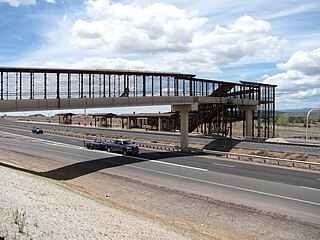
Santa Fe County/NM 599 is a station on the New Mexico Rail Runner Express commuter rail line, located southwest of Santa Fe, New Mexico, in Santa Fe County. It opened August 1, 2009.

Montaño is a station on the New Mexico Rail Runner Express commuter rail line on Montaño Rd. between Edith Blvd. and Second St., in Albuquerque, New Mexico. The station opened on April 7, 2014, marking the end of construction of the Montaño Transit Center.
Lisa Holt and Harlan Reano are a husband-and-wife team of Pueblo potters and artists from northern New Mexico. They have been making pottery together in 1999, they use traditional Cochiti pottery techniques and create modern work.
The Keres people are one of the Pueblo peoples. They speak English, Keresan languages, and in one pueblo Keresan Sign Language.

The North Central Regional Transit District operates a network of several local and intercity bus routes in northern New Mexico, serving Santa Fe, Española, Taos, and many smaller communities along a network of 25 fixed routes and one demand-response route, one dial-a-ride and complementary Paratransit service in the Taos area. Routes operate Monday through Friday only, with the exceptions of the "Taos Express," which operates only on weekends, the Mountain Trail route to the Santa Fe National Forest and Ski Santa Fe, which operates daily, and seasonal daily service from the Town of Taos to Taos Ski Valley. All routes are fare-free, with the exception of the Taos Express and Mountain Trail route which are premium fare-based routes. The service is supported primarily by transit gross receipt taxes, which provides approximately 70% of the RTD's revenues. In 2022, the system had a ridership of 109,500, or about 400 per weekday as of the second quarter of 2023.

The Santo Domingo Indian Trading Post, at Domingo, New Mexico on Santo Domingo Pueblo land dates from 1922. It was listed on the National Register of Historic Places in 1998.
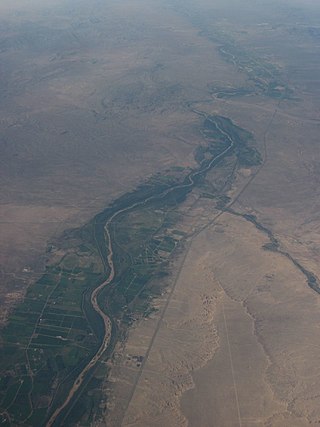
The Rio Grande Valley is the river valley carved out by the Rio Grande as it flows through the American Southwest and northeastern Mexico, forming a part of the border region. In the US state of New Mexico, the river flows mostly north to south, and forms a valley near Cochiti Pueblo to the state line near El Paso, Texas along the floors of the large sedimentary basins of the Rio Grande Rift, and includes the narrow sections between the basins. It has been historically settled first by the Pueblo peoples, the Spanish, the Mexicans, and finally Anglo-Americans. As the largest river in the state, some of its most populous cities are located wholly or partially in the valley, including Albuquerque, New Mexico's largest city.

















